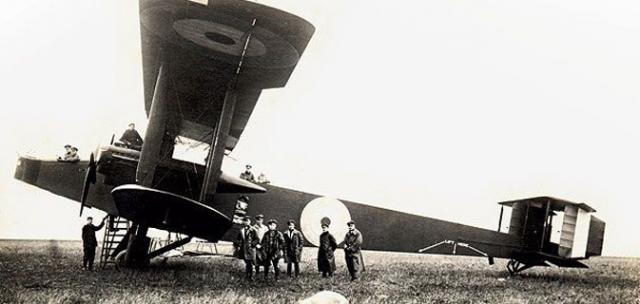
Night Bombers of WWI
World War One was called “The War to End All Wars. By May of 1918, over 30 million combatants had been killed or wounded. Towards midsummer more than 8,000 military aircraft were in action along the Western Front. However, the rapid attrition in aircraft and pilots caused the Allies to turn to night bombing.
The 100 Squadron was the pioneer night bombing squadron in France from March 1917 to end of war in 1918. It was comprised of pilots from France, England and America. The Handley Page O/400 was the mainstay of the Allied bomber fleet. It was a twin engine heavy biplane bomber, nicknamed “The Bloody Paralyzer”. It had a 165 ft. wingspan and carried a 1,650 lb. bomb load of either high explosives or incendiaries. It was flown by a crew consisting of a pilot, observer/bombardier, and rear gunner – all perched out in the open. The pilot had a steering wheel similar to ones used on Ford Model T. He sat in a wicker chair on a cushion – no parachutes were provided. If the airplane was hit by enemy flack, it took all three crewmen all the way to the ground. – sometimes screaming as they burned to death. The ground forces could hear them as they dove to their deaths. These were brave men.
All flights originated in France and were flown entirely in darkness, in order to avoid the terrible antiaircraft fire from the German 88 mm guns. The plane climbed at 60 mph, cruised at 60 mph and made its bomb run at 65 mph. It had to fly straight and true during the bomb run, as any heavy maneuvering could pull the wings off the fuselage.
Most pilots were trained at Aerodrome Handley Page Stonehenge, right next to the ruins. The aircraft had rudimentary instruments, and relied on a clock, airspeed indicator, and compass to fly through weather good or bad. Ground-mounted signal lights gave the pilots an initial point (IP) for navigating.
My grandfather flew the last night bombing mission before the armistice was signed His mission commenced in the evening of 11-10-1918 on an incendiary run to the German aerodrome at Frezkartny, France. The War ended on the 11th hour of the 11th day of the 11th month of 1918. I have my grandfathers diary plus other documents covering his time as a bomber pilot.